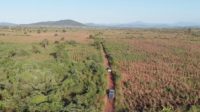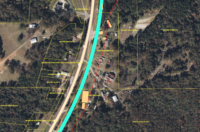Major construction work is imminent for the South Carolina Dept. of Transportation’s (SCDOT) largest project in history, a $2.08-billion rebuild of a busy, clogged series of interstate interchanges in Columbia dubbed “malfunction junction.”
The Carolina Crossroads project will widen 14 miles of interstate and construct seven interchanges, including two interstate-to-interstate and five service road interchanges, according to Brian Klauk, SCDOT's project manager. A joint venture of Archer Western and United Infrastructure Group was awarded a contract for the project's first two phases, estimated at $335 million.
“Malfunction Junction has been an area that SCDOT has needed to completely reconstruct for a very long time,” he said. “We’re grateful to the legislature for bringing some additional money.”
A gas-tax increase passed in 2017 is partially funding this and other projects, Klauk said, with the state picking up 10% of the project budget and the federal government 90%.
The area has some design holdovers from the 1950s and '60s, he said, like the cloverleaf interchange at I-26 and I-20, that will be rebuilt as a turbine interchange. Also, the original project was never fully completed, with roads planned to run parallel to the interstate never constructed.
All that leads to “malfunction junction” not functioning the way it was intended to, Klauk said.
More than 134,000 motorists traverse the interchange every day, according to SCDOT’s project website, where they spend an estimated average of 112 hours in traffic every year.
“This is going to be a radical improvement,” Klauk said. “SCDOT is completely committed to making sure this entire program gets completed.”
Phase 1 will include a new full-access interchange at Colonial Life Boulevard to replace the Bush River Road interchange to improve traffic flow, and extending the I-26 exit ramp onto US 378 to accommodate large numbers of vehicles that exit there in the afternoons.
Archer-United Joint Venture—a team of Archer Western Construction LLC and United Infrastructure Group Inc.—was awarded the re-design and construction bid for the first two phases, with Infrastructure Consulting & Engineering leading the design.
Andy Douglas, vice president of Carolinas transportation for Archer Western, said major construction work on Phase 1 should start in June and wrap up in October 2024. Phase 2 is set to start in September with a February 2025 substantial completion date.
Work is currently underway to relocate a 30-in sewer force main and relocate a South Carolina state government fiber-optic cable, Klauk said, along with significant logging, clearing and marking no-go zones like the historic Saluda River canal.
Used in the 18th and 19th centuries to allow boats to avoid rapids on the Saluda River, the now-dry canal will be left completely undisturbed during construction, Klauk said, and archaeologists were called in to delineate the site.
The project has secured its National Environmental Policy Act (NEPA) approval and finalized its Record of Decision and Environmental Impact Statement, he said. All that remains is a notice of intent from the South Carolina Dept. of Environmental Control, Douglas said.
About $350 million worth of work has been awarded, according to Klauk, rights-of-way for which have all been acquired.
For Archer-United, that work starts with "Bridge 35," the critical path for Phase 1, Douglas said.
The seismic-designed bridge will require large-diameter drilled shafts into rock, he said, and accessing the site over the Saluda River and between railroad tracks also presents a challenge, as does the curved geometry of the bridge itself.
Phase 2 includes the construction of an offset diverging-diamond interchange, Douglas said, with plans to construct the new bridge alongside the existing one.
The offset design will allow construction to start with existing utilities like power and fiber remaining in place, he said, though some right-of-way acquisition remains to be completed before work can start there.
The diverging-diamond interchange crosses traffic on the non-interstate roadway to the left side of the road as it crosses over the interstate, eliminating conflict points by allowing all drivers merging onto the interstate to do so without crossing oncoming traffic.
It's not a common design in the area, Douglas said, though Archer Western is working on a widening project on I-26 nearby that also includes a diverging diamond.
The first three phases of the five-phase Carolina Crossroads project set to wrap up in 2029 are design-build contracts, Klauk said, with Phases 4 and 5 planned as traditional bid-build delivery, letting out in 2025 and 2027 respectively.
Phase 3, the largest, will start procurement in September, he said, with a contractor named toward the end of 2023.
SCDOT is working with two prime consultants on the Carolina Crossroads project, Klauk said, HDR Engineering of the Carolinas for project management, NEPA support and preliminary design, and CDM Smith, responsible for the verification testing and inspection program.
Instead of traditional owner construction engineering and inspection, quality acceptance testing is a responsibility of the contractor, he said, while SCDOT will complete statistical verification and sampling to make sure their tests are accurate and correct.
“SCDOT has put on itself all the risk that it can reasonably handle: right-of-way acquisition, acquiring necessary environmental permits and risk of early utility coordination,” Klauk said. “We’ve put that on ourselves and gone ahead and secured all that. It means our contractors don’t have to shoulder the burden of that risk for long-duration contracts.”






Post a comment to this article
Report Abusive Comment